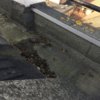I’m trying to get to grips with a water damage problem on one side of a 4 storey late Victorian house in London. There’s a flat area - looks like a trough - in front of the sloping roof, so presumably when it rains, all the water goes into there. But from there, how does it drain? There’s no gutter. And lots of problems with water cascading down the side of the building in rainy weather. Something’s not right...
(a couple of photos attached)
Can anyone shed any light on this please? I’m a bit ignorant I’m afraid.
(a couple of photos attached)
Can anyone shed any light on this please? I’m a bit ignorant I’m afraid.







